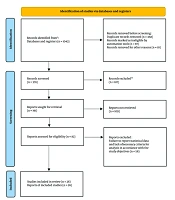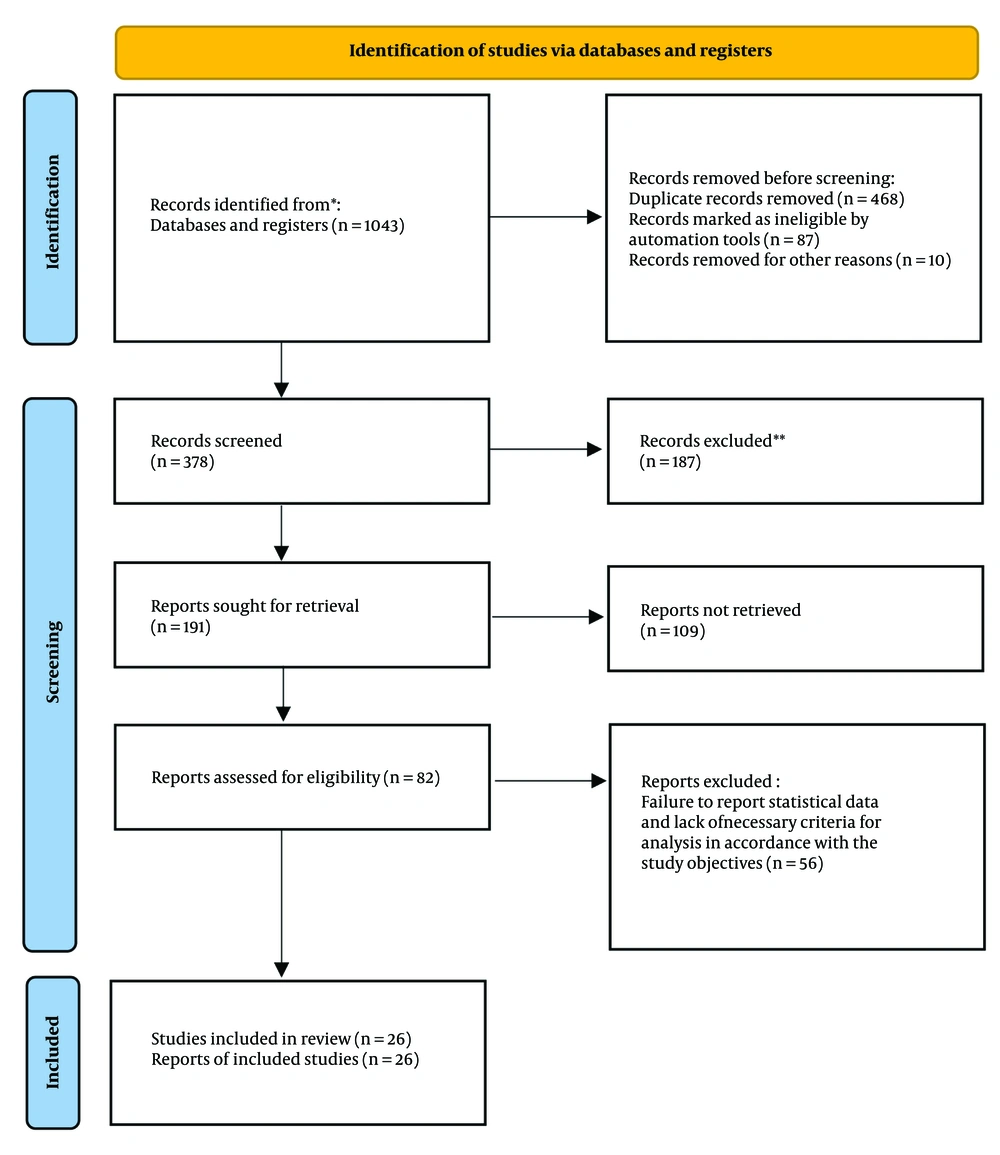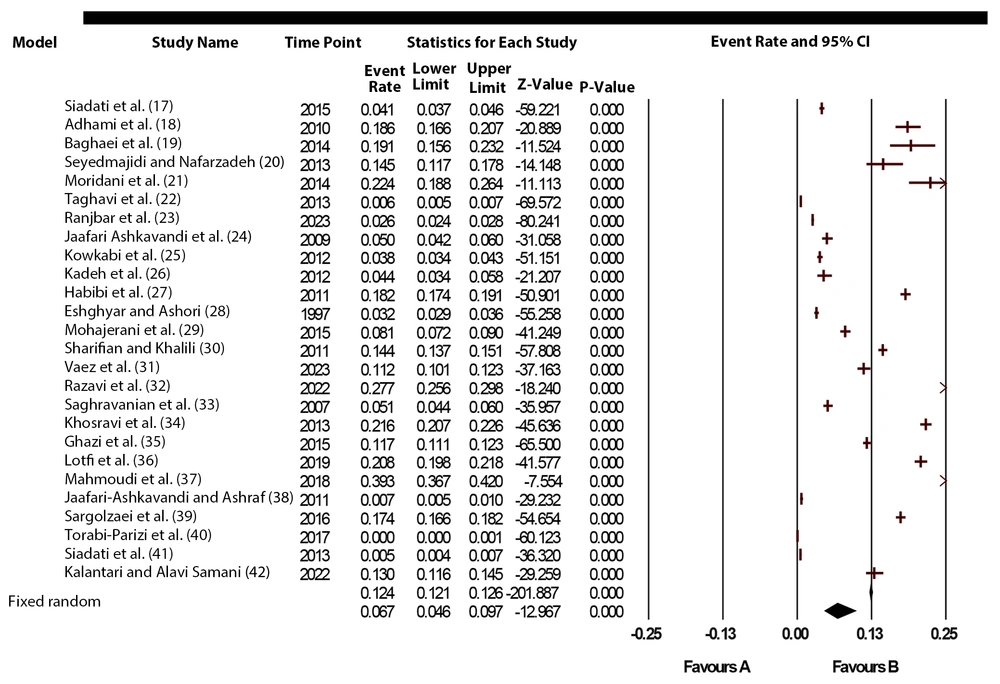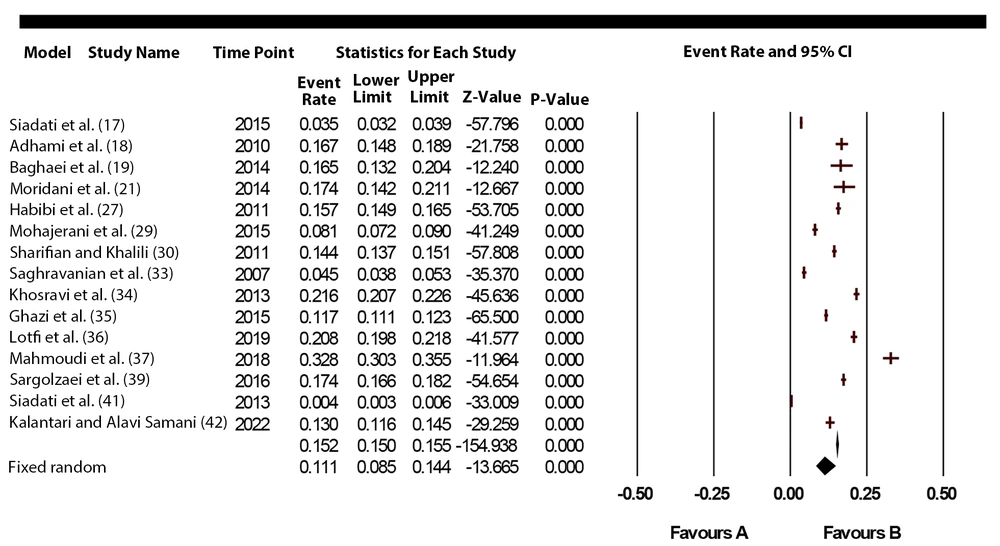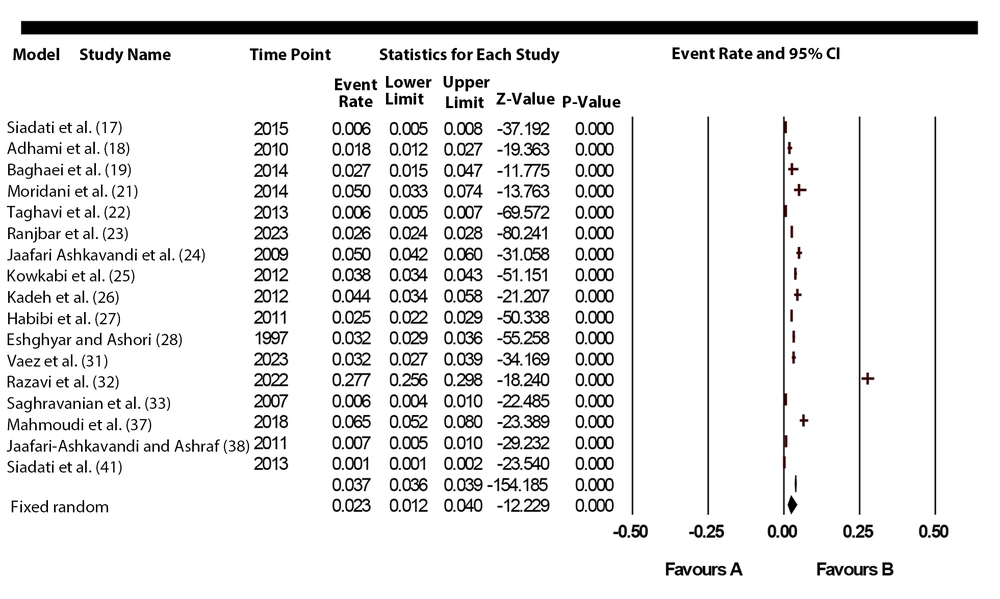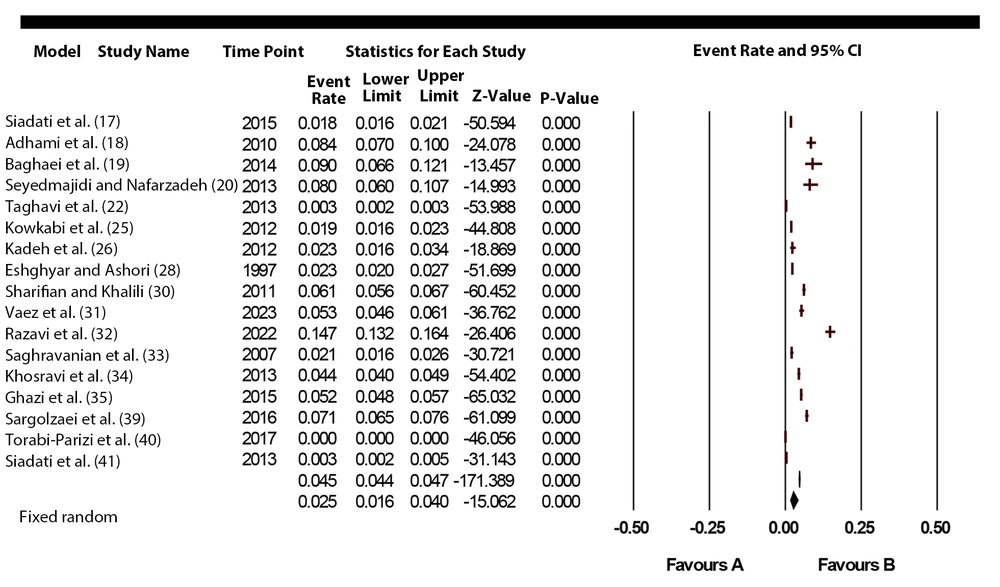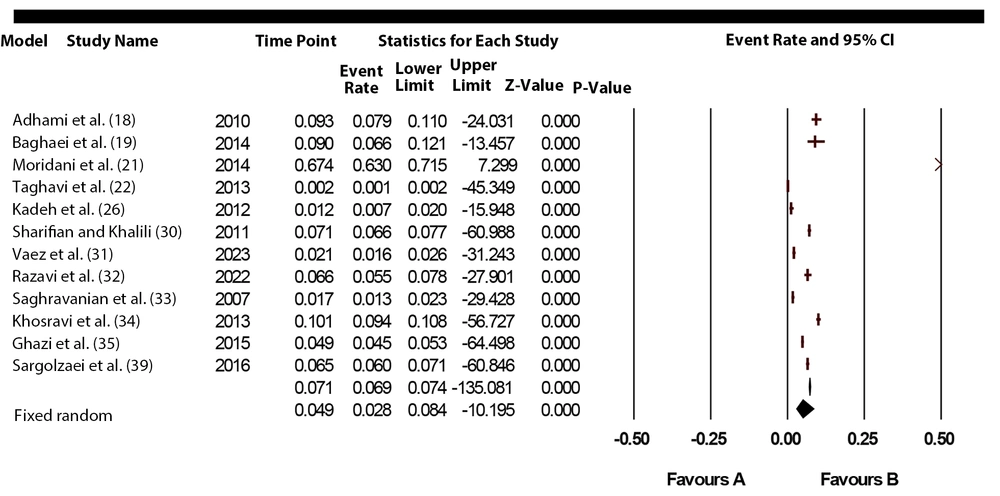1. Context
Cancer is a chronic, progressive, and incurable disease that has led to many complications for patients, including psychological, physical, and even death (1-4). Despite the progress made in the diagnosis and treatment of cancer, the complications of this disease are high, and the survival rate of patients is reported to be low. Different cancers have different growth trends, complications, and survival rates, and according to the importance of this disease, the prevalence of each type of cancer should be investigated separately (5).
Oral cancer (OC) is one of the types of cancer, whose prevalence varies according to age, gender, race, geographical region, lifestyle, and diet, like other types of cancer (6). The prevalence of oral cavity and lip cancers is 377 713, and the global mortality rate is 177 757 (7, 8). Oral cancer has a very bad prognosis, which is about 40%. If OC is diagnosed in stages I and II, its survival rate can increase to more than 80% (9, 10).
If OC is not diagnosed at the right time and in the early stages, irreparable malignancies will develop in the body and cause organ dysfunction along with pain and discomfort. For this reason, to prevent deaths in OC, complete and appropriate information on the prevalence of OC should be provided to the treatment staff (7, 11).
Odontogenic tumors and cysts (AOD) are an important part of oral and maxillofacial pathology, each of which is of special clinical importance due to its different biological behavior. These tumors are a complex group of lesions with different histopathological and clinical types that originate from odontogenic epithelium. Odontogenic tumors are asymptomatic but can cause jaw expansion, tooth movement, and bone destruction (12).
The differences in oral health status are the result of many factors, including social, environmental, biological, behavioral, cultural, economic, and political factors, limited access to oral health care, lack of oral and dental health information tools. Oral and dental diseases play an important role in the patient's health, and one of these diseases is AOD. Having sufficient information on the prevalence of these tumors is important and necessary in determining the planning and carrying out the necessary interventions for the prevention and treatment of these tumors (13-15).
2. Objectives
In studies conducted in Iran, various statistics have been mentioned regarding the amount of AOD, which makes it impossible to reach a systematic and coherent conclusion regarding the aforementioned statistics. For this reason, the aim of the study is to investigate the prevalence of odontogenic cysts and tumors in Iran.
3. Methods
In this meta-analysis study, which was conducted using the PRISMA checklist (16), all published articles on the prevalence of tumors and odontogenic cysts were included in the study.
3.1. Inclusion and Exclusion Criteria
3.1.1. Inclusion Criteria
Articles published in the Iranian setting, in which the prevalence or the number of odontogenic cysts and tumors were reported, were included in the study. The search timeframe was limited to articles from 2000 to 2024, and the quality of the extracted articles was the inclusion criterion for the study.
3.1.2. Exclusion Criteria
Systematic review studies and case reports were excluded from the study.
3.2. Information Sources and Study Selection
The search was conducted across various international databases, including ISI, Scopus, PubMed, EBSCO, ScienceDirect, Magiran, and SID.
3.3. Search Strategy
Before initiating the search, attempts were made to gather all the factors affecting AOD, based on which the search keywords could be selected. Accordingly, the keywords included “Odontogenic tumors” [MeSH], “Odontogenic cysts” [MeSH], “tumors” [MeSH], “cysts” [MeSH], “Maxilla” [MeSH], “Mandible” [MeSH], “Epidemiology” [MeSH], “Cancer” [MeSH], “Dental” [MeSH], and “Tooth” [MeSH].
3.4. Quality of the Articles
This checklist had 7 questions in the fields of years, sample size, city, female (n), male (n), type of study, and prevalence. Articles with a checklist score of less than 3 were excluded from the review process (Table 1).
| No. | Authors | Years | Sample Size | City | Female (n) | Male (n) | Type of Study | Prevalence | Total Score |
|---|---|---|---|---|---|---|---|---|---|
| 1 | Siadati et al. (17) | √ | √ | √ | √ | √ | √ | √ | 7 |
| 2 | Adhami et al. (18) | √ | √ | √ | √ | √ | √ | √ | 7 |
| 3 | Baghaei et al. (19) | √ | √ | √ | √ | √ | √ | √ | 7 |
| 4 | Seyedmajidi and Nafarzadeh (20) | √ | √ | √ | √ | √ | √ | √ | 7 |
| 5 | Moridani et al. (21) | √ | √ | √ | - | - | √ | √ | 5 |
| 6 | Taghavi et al. (22) | √ | √ | √ | √ | √ | √ | √ | 7 |
| 7 | Ranjbar et al. (23) | √ | √ | √ | - | - | √ | √ | 5 |
| 8 | Jaafari Ashkavandi et al. (24) | √ | √ | √ | - | - | √ | √ | 5 |
| 9 | Kowkabi et al. (25) | √ | √ | √ | √ | √ | √ | √ | 7 |
| 10 | Kadeh et al. (26) | √ | √ | √ | √ | √ | √ | √ | 7 |
| 11 | Habibi et al. (27) | √ | √ | √ | - | - | √ | √ | 5 |
| 12 | Eshghyar and Ashori (28) | √ | √ | √ | √ | √ | √ | √ | 7 |
| 13 | Mohajerani et al. (29) | √ | √ | √ | - | - | √ | √ | 5 |
| 14 | Sharifian and Khalili (30) | √ | √ | √ | √ | √ | √ | √ | 7 |
| 15 | Vaez et al. (31) | √ | √ | √ | √ | √ | √ | √ | 7 |
| 16 | Razavi et al. (32) | √ | √ | √ | √ | √ | √ | √ | 7 |
| 17 | Saghravanian et al. (33) | √ | √ | √ | √ | √ | √ | √ | 7 |
| 18 | Khosravi et al. (34) | √ | √ | √ | √ | √ | √ | √ | 7 |
| 19 | Ghazi et al. (35) | √ | √ | √ | √ | √ | √ | √ | 7 |
| 20 | Lotfi et al. (36) | √ | √ | √ | - | - | √ | √ | 5 |
| 21 | Mahmoudi et al. (37) | √ | √ | √ | - | - | √ | √ | 5 |
| 22 | Jaafari-Ashkavandi and Ashraf (38) | √ | √ | √ | - | - | √ | √ | 5 |
| 23 | Sargolzaei et al. (39) | √ | √ | √ | √ | √ | √ | √ | 7 |
| 24 | Torabi-Parizi et al. (40) | √ | √ | √ | √ | √ | √ | √ | 7 |
| 25 | Siadati et al. (41) | √ | √ | √ | √ | √ | √ | √ | 7 |
| 26 | Kalantari and Alavi Samani (42) | √ | √ | √ | - | - | √ | √ | 5 |
The Quality of the Articles
3.5. Data Collection and Statistical Analysis
The researchers used a checklist that included items such as the number of anatomical locations (Maxilla and Mandible), the number of odontogenic tumors, the number of odontogenic cysts, and the total number of patients. These data were entered into Table 1 and analyzed using CMA software.
4. Results
Results showed that of the 1043 articles found in the initial search, 26 articles were entered into the meta-analysis stage, and data analysis was done for them (Figure 1).
The prevalence of AOD was 0.124 (CI = 0.121 - 0.126) based on the Fixed analysis model and 0.067 (CI = 0.097 - 0.046) in the Random analysis model. Also, based on the Random model, the prevalence of Odontogenic cysts was equal to 0.111 (CI = 0.085 - 0.144) and the prevalence of Odontogenic tumors was equal to 0.023 (CI = 0.012 - 0.040) (Tables 2 and 3, Figures 2 - 8).
| No. | Author | Years | City | Total Number of Patients | Total Odontogenic | Odontogenic Cysts | Odontogenic Tumors | Male | Female | Anatomical Location of Odontogenic | |
|---|---|---|---|---|---|---|---|---|---|---|---|
| Maxilla | Mandible | ||||||||||
| 1 | Siadati et al. (17) | 2015 | Babol | 8956 | 370 | 317 | 53 | 205 | 165 | - | - |
| 2 | Adhami et al. (18) | 2010 | Kerman | 1320 | 245 | 221 | 24 | 134 | 111 | 123 | 194 |
| 3 | Baghaei et al. (19) | 2014 | Hamadan | 413 | 79 | 68 | 11 | 42 | 37 | 37 | 21 |
| 4 | Seyedmajidi and Nafarzadeh (20) | 2013 | Babol | 512 | 74 | - | - | 33 | 41 | - | - |
| 5 | Moridani et al. (21) | 2014 | Tehran | 460 | 103 | 80 | 23 | - | - | 310 | 150 |
| 6 | Taghavi et al. (22) | 2013 | Tehran | 30706 | 188 | - | 188 | 104 | 84 | 50 | 138 |
| 7 | Ranjbar et al. (23) | 2023 | Tehran | 19380 | 503 | - | 503 | - | - | - | - |
| 8 | Jaafari Ashkavandi et al. (24) | 2009 | Shiraz | 2343 | 117 | - | 117 | - | - | - | - |
| 9 | Kowkabi et al. (25) | 2012 | Isfahan | 6860 | 260 | - | 260 | 127 | 133 | - | - |
| 10 | Kadeh et al. (26) | 2012 | Zahedan | 1125 | 50 | - | 50 | 24 | 26 | 13 | 36 |
| 11 | Habibi et al. (27) | 2011 | Mashhad | 7707 | 1403 | 1208 | 195 | - | - | - | - |
| 12 | Eshghyar and Ashori (28) | 1997 | Tehran | 8451 | 273 | - | 273 | 78 | 195 | - | - |
| 13 | Mohajerani et al. (29) | 2015 | Tehran | 3875 | 312 | 312 | - | - | - | - | - |
| 14 | Sharifian and Khalili (30) | 2011 | Tehran | 8529 | 1227 | 1227 | - | 700 | 523 | 605 | 615 |
| 15 | Vaez et al. (31) | 2023 | Tehran | 3238 | 362 | - | 104 | 190 | 172 | 67 | 295 |
| 16 | Razavi et al. (32) | 2022 | Esfahan, shiraz, Yazd | 1800 | 498 | - | 498 | 231 | 265 | 118 | 352 |
| 17 | Saghravanian et al. (33) | 2007 | Mashhad | 3122 | 160 | 140 | 20 | 95 | 65 | 54 | 106 |
| 18 | Khosravi et al. (34) | 2013 | Isfahan | 7412 | 1603 | 1603 | - | 418 | 328 | 746 | 857 |
| 19 | Ghazi et al. (35) | 2015 | Mashhad | 10165 | 1189 | 1189 | - | 657 | 532 | 495 | 694 |
| 20 | Lotfi et al. (36) | 2019 | Tehran | 5865 | 1219 | 1219 | - | - | - | - | - |
| 21 | Mahmoudi et al. (37) | 2018 | Tehran | 1267 | 498 | 416 | 82 | - | - | - | - |
| 22 | Jaafari-Ashkavandi and Ashraf (38) | 2011 | Shiraz | 5018 | 35 | - | 35 | - | - | - | - |
| 23 | Sargolzaei et al. (39) | 2016 | Tehran | 8563 | 1489 | 1489 | - | 884 | 605 | 560 | 929 |
| 24 | Torabi-Parizi et al. (40) | 2017 | Kerman | 134722 | 61 | - | - | 31 | 30 | - | - |
| 25 | Siadati et al. (41) | 2013 | Babol | 8956 | 49 | 36 | 13 | 19 | 30 | - | - |
| 26 | Kalantari and Alavi Samani (42) | 2022 | Kerman | 2092 | 271 | 271 | - | - | - | - | - |
Specifications of the Articles
| Tumor type | Fixed | Random |
|---|---|---|
| Odontogenic cysts and odontogenic tumors | 0.124 (CI = 0.121 - 0.126) | 0.067 (CI = 0.046 - 0.097) |
| Odontogenic cysts | 0.152 (CI = 0.150 - 0.155) | 0.111 (CI = 0.085 - 0.144) |
| Odontogenic tumors | 0.037 (CI = 0.036 - 0.039) | 0.023 (CI = 0.012 - 0.040) |
| Odontogenic tumors and cysts in males | 0.057 (CI = 0.056 - 0.059) | 0.026 (CI = 0.016 - 0.042) |
| Odontogenic tumors and cysts in females | 0.045 (CI = 0.044 - 0.047) | 0.025 (CI = 0.016 - 0.040) |
| Odontogenic tumors and cysts in the maxilla | 0.071 (CI = 0.069 - 0.074) | 0.049 (CI = 0.028 - 0.084) |
| Odontogenic tumors and cysts in the mandible | 0.090 (CI = 0.087 - 0.092) | 0.073 (CI = 0.047 - 0.111) |
Prevalence of Odontogenic Cysts and Tumors in Iran
5. Discussion
Cancer is a chronic disease with high prevalence that may affect different parts of the body (43). In this meta-analysis study, the prevalence of Ots was 0.111 (CI = 0.085 - 0.144) and the prevalence of AOT was 0.067 (CI = 0.046 - 0.097). In the study by Mello et al., which analyzed the results of 16 articles, the prevalence of AOD was reported as 5.3%, the prevalence of Ots was reported as 4.4%, and the prevalence of Odontogenic tumors was reported as 5% (44).
Regarding the original studies that investigated the prevalence of AOT, we can refer to the study by Izgi et al. in Turkey. In this retrospective study, the number of 739 oral and dental lesions from 2008 to 2018 were examined, of which 467 were related to odontogenic cysts and 50 were related to odontogenic tumors (45). In the study of Shekar et al. in India, in 204 cases and 1 331 biopsies examined from 2007 to 2012, the prevalence of OCs was 9.6% and the prevalence of Ots was 5.7% (46). In Akram et al.'s study in Pakistan between 2001 and 2010, investigating 6 000 patients, the prevalence of OCs was 1.6% and the prevalence of Ots was 2.35% (47).
The prevalence of AOT has been reported in several studies. In Canada, a study involving 445 patients identified 14 cases (48). Similarly, research in Mexico (n = 349) found 25 cases (49), while a study in China (n = 759) reported 63 cases (50). Additionally, studies in Chile (n = 362) and Brazil (n = 340) documented 24 (51) and 13 cases (52), respectively.
In this meta-analysis study, the prevalence of AOT in men was 0.026 (CI = 0.016 - 0.042) and in women was 0.025 (CI = 0.016 - 0.040). In some studies, the prevalence of inflammatory cysts in men has been higher than in women. In the study of Acikgoz et al. in Turkey, the prevalence in men was 54.4% (53), in the study of Al Sheddi, the prevalence in men was 54.8% (54), in the study of Bataineh et al. in Jordan, the prevalence was 65.4% (55), in the study of Del Corso et al. in Italy, the prevalence was 61% (56), in the study of Kilinc et al. in Turkiye, the prevalence was 59.9% (57) and in the study of Lo Muzio et al. in Italy, it was 64.1% (58).
In this meta-analysis study, the prevalence of the anatomical location of odontogenic in the Maxilla was 0.049 (CI = 0.028 - 0.084) and in the Mandible was 0.073 (CI = 0.047 - 0.111). In the study of Johnson et al. in Australia, the prevalence of AOT in the mandible was higher than in the maxilla. Also, concerning the prevalence of OCs in the mandible and maxilla, no difference was observed in terms of the prevalence of OCs (59). Likewise, in the study by Johnson et al. in Mexico, where 753 cases of OC were examined, 41% of the reported OCs were in the mandibular posterior area (59).
5.1. Conclusions
Since the prevalence of odontogenic cysts and tumors was significant in this meta-analysis study, it is suggested to take necessary measures and screening for the prevention of AOT and OCs.
